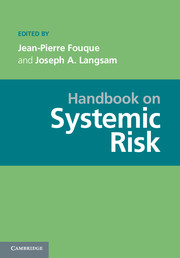Book contents
- Frontmatter
- Contents
- Contributors
- Introduction
- PART I DATA: THE PREREQUISITE FOR MANAGING SYSTEMIC RISK
- PART II STATISTICS AND SYSTEMIC RISK
- PART III MEASURING AND REGULATING SYSTEMIC RISK
- PART IV NETWORKS
- PART V SYSTEMIC RISK ANDMATHEMATICAL FINANCE
- 14 Firms, Banks and Households
- 15 An Agent-Based Computational Model for Bank Formation and Interbank Networks
- 16 Diversification in Financial Networks may Increase Systemic Risk
- 17 Systemic Risk Illustrated
- 18 Financial Crisis and Contagion: A Dynamical Systems Approach
- PART VI COUNTERPARTY RISK AND SYSTEMIC RISK
- PART VII ALGORITHMIC TRADING
- PART VIII BEHAVIORAL FINANCE: THE PSYCHOLOGICAL DIMENSION OF SYSTEMIC RISK
- PART IX REGULATION
- PART X COMPUTATIONAL ISSUES AND REQUIREMENTS
- PART XI ACCOUNTING ISSUES
- References
18 - Financial Crisis and Contagion: A Dynamical Systems Approach
from PART V - SYSTEMIC RISK ANDMATHEMATICAL FINANCE
Published online by Cambridge University Press: 05 June 2013
- Frontmatter
- Contents
- Contributors
- Introduction
- PART I DATA: THE PREREQUISITE FOR MANAGING SYSTEMIC RISK
- PART II STATISTICS AND SYSTEMIC RISK
- PART III MEASURING AND REGULATING SYSTEMIC RISK
- PART IV NETWORKS
- PART V SYSTEMIC RISK ANDMATHEMATICAL FINANCE
- 14 Firms, Banks and Households
- 15 An Agent-Based Computational Model for Bank Formation and Interbank Networks
- 16 Diversification in Financial Networks may Increase Systemic Risk
- 17 Systemic Risk Illustrated
- 18 Financial Crisis and Contagion: A Dynamical Systems Approach
- PART VI COUNTERPARTY RISK AND SYSTEMIC RISK
- PART VII ALGORITHMIC TRADING
- PART VIII BEHAVIORAL FINANCE: THE PSYCHOLOGICAL DIMENSION OF SYSTEMIC RISK
- PART IX REGULATION
- PART X COMPUTATIONAL ISSUES AND REQUIREMENTS
- PART XI ACCOUNTING ISSUES
- References
Summary
Abstract We use a multi-agent-based model to investigate and analyze financial crises where agents are large aggregates of the economic system under consideration. We analyze financial crises as the breakage of a dynamic financial equilibrium. We suggest that when the equilibrium is stable, a small perturbation is absorbed by the market. On the other hand, when the market becomes unstable, perturbations propagate and amplify through the system, and contagion and systemic risk occur, resulting in a global financial crisis.
The market instability indicator is the spectral radius of the Jacobian matrix of a dynamical system driving the evolution of the economy. Entries of this Jacobian matrix can be computed by estimating the elasticities of flows of funds between aggregate agents. The higher the elasticities, the larger the entries of the Jacobian matrix and the more unstable the economy. High leverage and borrowing capacity constraints increase elasticities and make the market unstable as soon as the market instability indicator is above the critical value 1.
In order to avoid deflation and economic collapse in 2008, the US government had a very strong reaction with Quantitative Easing and TARP. This put the market under rapid oscillations of very high amplitude and chaotic behavior, making long term forecasts inefficient. By correctly monitoring and utilizing elasticities, governments facing a major crisis may be able to optimize the efficiency of monetary and fiscal policies and accurately allocate their support to the various sectors of the economy, as opposed to being part of the origination of market chaos by inappropriate allocation of government resources.
- Type
- Chapter
- Information
- Handbook on Systemic Risk , pp. 453 - 480Publisher: Cambridge University PressPrint publication year: 2013
References
- 9
- Cited by



